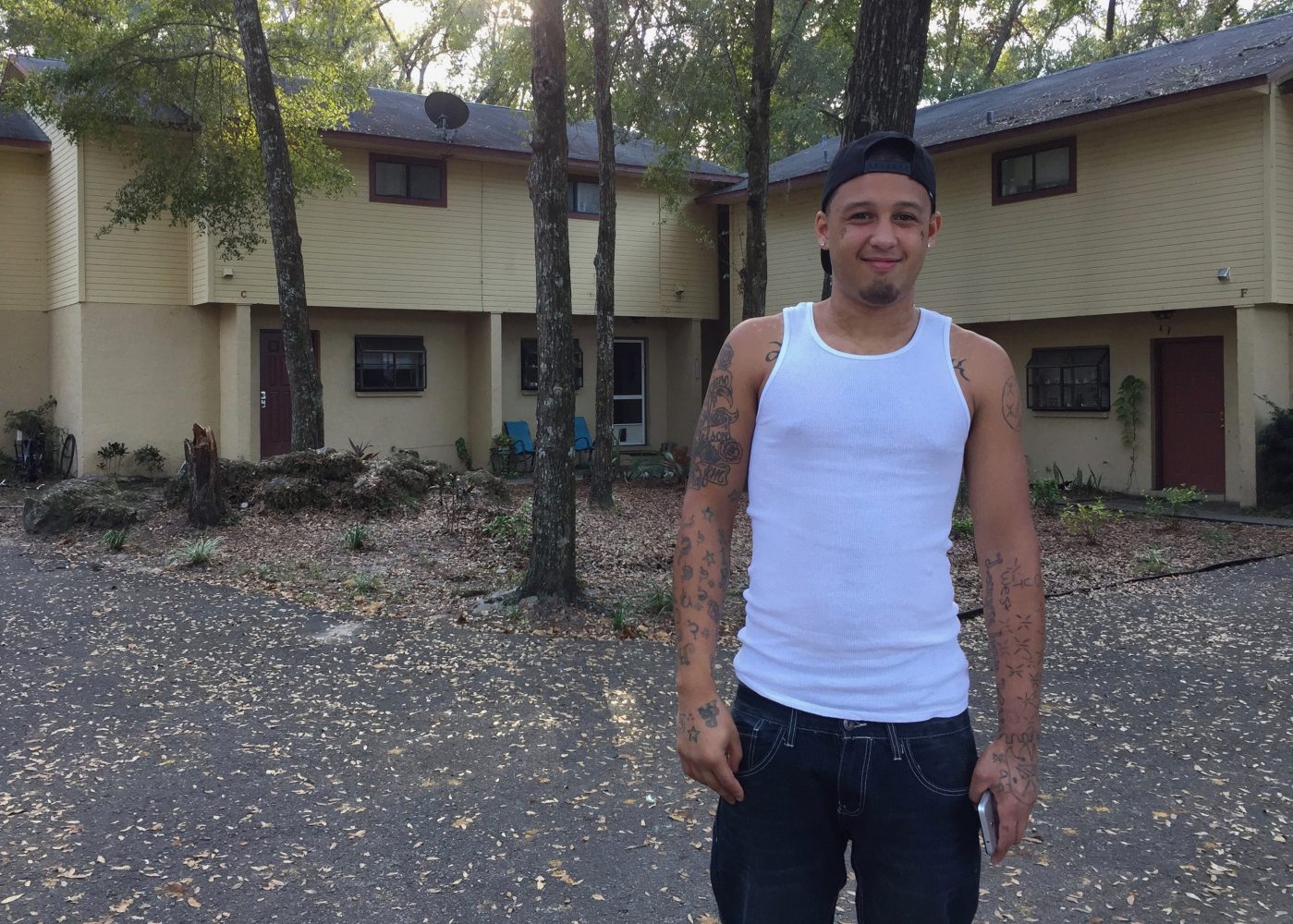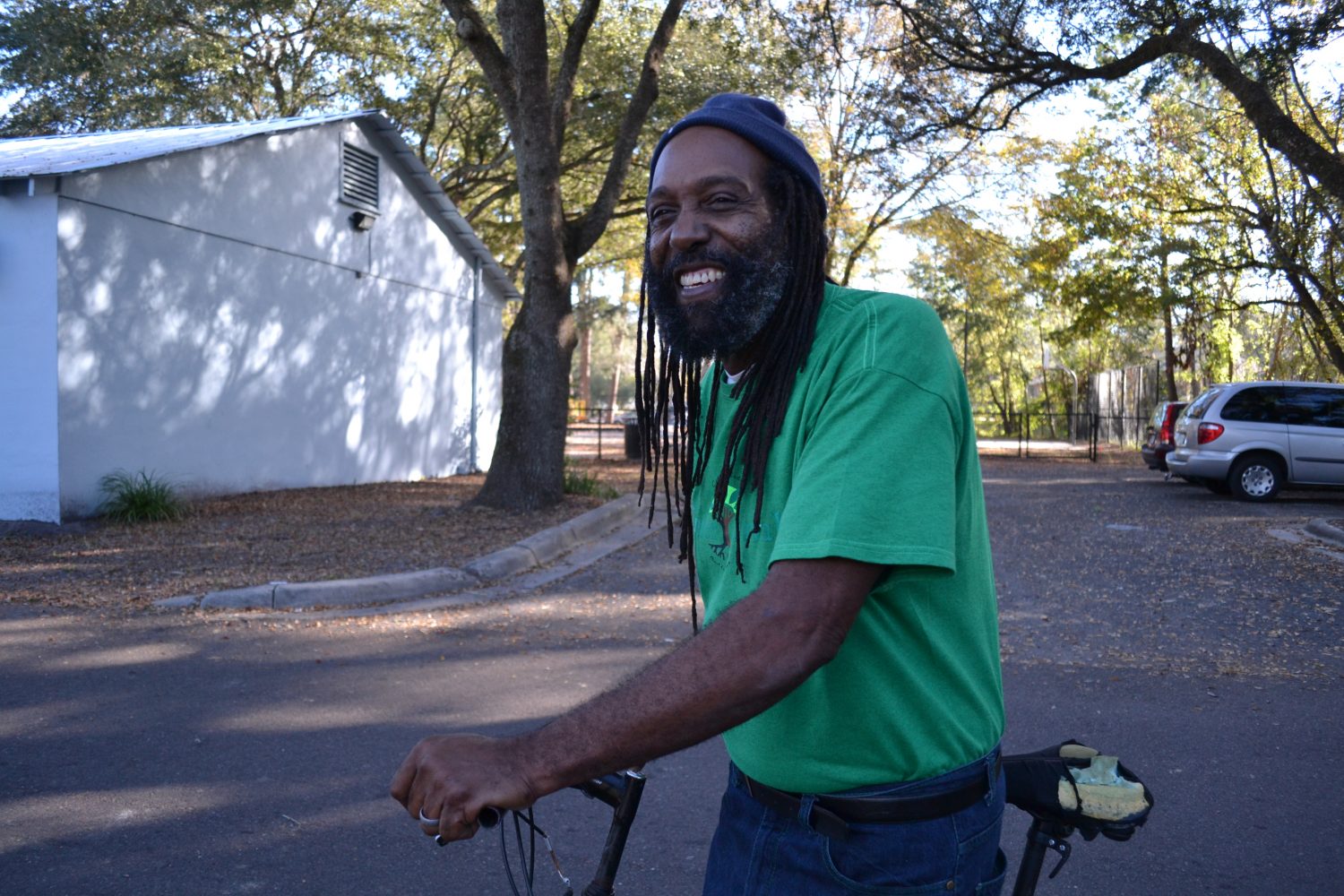<!– –>
<!– –>
<!– –>
<!– –>
<!– –>
<!– –>
By Monica Humphries | December 19, 2017
<!– –>
Luis Alamo laces up his black, slip-resistant shoes and checks his wallet.
If he has $2, he takes the bus. If his wallet is empty, he walks.
He lives in Southwest Gainesville and works at Perkins Restaurant & Bakery near The Oaks Mall.
“Either way getting there takes a lot of time,” he said. “And it’s just not reliable.”
It’s an hour’s walk or a 35-minute wait for a bus. The buses are inconsistent; sometimes 15 or 20 minutes late, and other times 10 minutes early. Once he’s on, it’s a nine-minute ride.
Most of his commute is spent sitting on a cement bench waiting, he said.

Alamo’s daily struggle to get to work represents a serious problem in Alachua County – transportation for low-income residents. Just as the poor have a higher energy burden than other income brackets – using less energy overall, yet paying a higher percentage of their income for utilities – low-income families must devote more of their household budget to transportation, according to The Pew Charitable Trusts.
The issues are inextricably linked: “Transportation challenges are a direct consequence of a family’s lack of funds,” says Tiffany McKenzie, director of community development Central Florida Community Action Agency. “However, they are frequently also a direct cause of a lack of funds.”
Cost is often the top transportation challenge faced by low-income residents in Alachua County, McKenzie said. The data came from 644 surveys distributed to local elected officials, faith-based organizations, community partners and clientele. Thirty-five percent of respondents said “no funds for gas or bus fare” was the main transportation barrier.
“Transportation remains a major challenge for many families,” McKenzie said. “Households with a restricted income cannot afford the cost of running and maintaining their own vehicle.”
Pew reports that in 1996, the lowest-income households nationally paid about $2,000 annually for car fuel, insurance, maintenance and repair and public transportation. Twenty years later, the same group spent more than that every year on fuel alone. “These extreme cost increases force households to make difficult choices and trade-offs to meet core needs,” according to Pew.
The public transportation divide
In Gainesville, one of the leading solutions to these stressors – good public transportation – comes with its own divide. For one, University of Florida students, faculty and staff ride Regional Transit System city buses for “free;” though in reality they pay for the service through student fees and a partnership with UF to reduce the number of cars on campus.
Lower-income areas have less-frequent buses that don’t run as early or as late as those catering to the UF, said Ruth Steiner, a professor of urban and regional planning who is also part of UF’s Transportation Institute.
“Go to the east side of town and meander around and buses run maybe once an hour,” she said. “But the routes that serve students are frequent and direct.”
Advocates for low-income families agree that in areas such as Duval Neighborhood and parts of southwest Gainesville and east Gainesville, public transportation isn’t as accessible or reliable. Pamela Davis, the executive director of the Gainesville Housing Authority, said there is a serious transportation disparity across the city.
Her office building is tucked in the back of Woodland Park, a public housing neighborhood in east Gainesville. The community she works with uses every form of transportation, and over time she’s seen the advantages and disadvantages of each.
The main challenges involve public transportation, she said:
- A man living in southwest Gainesville with diabetes should visit a doctor’s office every week but isn’t willing to ride the three buses it takes to get to the health clinic.
- A single mother needs to pick her child up from after-school care but has a work shift and bus schedule that don’t line up.
- Someone works at The Oaks Mall until 11 p.m., which means s/he doesn’t have a way home because buses don’t run that late.
“The list goes on and on,” Davis said. “And I see these struggles every day.”
Andrew Miles, a representative for Greater Duval Neighborhood Association, said he sees the same problems.
“Many people say they’re satisfied with RTS,” he said. “But they wish it could run later and more often.”
In summer 2016, the Greater Duval Neighborhood Association surveyed the community. One of the questions was how satisfied residents were with public transportation. Out of 152 responses, 131 people said they found public transportation convenient. However, many of those responses included comments on how it could be better.

Every advocate, expert and rider agreed that it’s a cruel cycle: When a person can’t take a better paying job because of poor transportation, there’s a higher chance they’ll stay in poverty.
Wahoo Seafood Grill at 3833 NW 97th Blvd. is a classic example, said Davis.
Davis has worked with the manager to provide jobs for people in east Gainesville.
But because of the bus routes and schedules near the restaurant, it’s often not feasible for people in that community to work there.
For example, if a person left Wahoo Seafood Grill at 5 p.m., the quickest route is an hour and a half. If the rider misses that first bus, it would take closer to two hours, and each route involves more than 40 minutes of walking.
It might work for a single adult, but for families, it’s just not feasible, Davis said.
“Let’s say the daycare closes at 6 o’clock and you get off at 5 p.m.,” Davis said. “That just won’t work for you.”
Instead, her clients are taking lower-paying jobs without benefits because it’s the best option for some families.
Transportation touches everything
The lack of transportation isn’t just impacting jobs and daycare but access to health care, said Dorothy Thomas, a Southwest Advocacy Group co-chair. A ride to the nearest health clinic took three different buses and over an hour and a half.
Community Access to Child Health conducted a survey in southwest Gainesville and found that 33 percent of families were accessing health care through a doctor’s office; 23 percent via the health department; 18 percent by way of the emergency room; 14 percent weren’t accessing health care; and 12 percent accessing it some other way.
That n
early a third either relied on the ER or got no healthcare is a huge problem, Thomas said.
Transportation was the biggest barrier.
“It’s not that they didn’t want to get health care,” Thomas said. “It was that they couldn’t get to it.”
Instead of fixing the transportation problem, Southwest Advocacy Group worked with the health department to build a clinic directly in the community.
Bringing the resources and encouraging business within the community might be the easiest solution, Thomas said.
“You have to fight it bus trip by bus trip,” she said. “It’s always seemed more effective to bring the services to people than bring the buses to people.”
Davis serves on a Gainesville Chamber of Commerce committee that holds public information workshops to address problems like transportation.
“We need to find solutions for our poor communities,” she said.
The group is brainstorming solutions to the current system. Davis said one common solution is to create a smaller-scale shuttle service.
That would mean community members would have direct, fast transportation to job areas.
Chip Skinner, a spokesperson for the City of Gainesville, said misconceptions associated with public transportation discourage potential riders.
“Here in Gainesville there’s still a stigma attached to public transportation,” he said. “They feel it’s the indigent and the people that can’t afford a car.”
Those potential riders can strengthen the RTS system if they choose to take the bus.
The search for solutions
One issue with changing the bus system is funding.
Since the UF and Santa Fe College fund 55 percent of RTS’s operating costs, they influence many of the decisions.
“We listen to them,” Skinner said. “They’re not willing to put the money in those areas because they don’t see the need for their population.”
However, UF’s support may inadvertently benefit areas like east Gainesville.
“Where we’re better than other communities is that people from the east side of Gainesville who happen to work on the west side of Gainesville probably get better service than they would in other similarly sized communities,” Steiner said.
Just because it’s better doesn’t mean it’s good, Davis said.
“You need to get to and from a game, that’s not an issue,” Davis said. “But if you need to get to and from work, that’s an issue. If you need to get to get your kid to and from daycare, that’s an issue.”
Many advocates say long-term solutions involve equalizing Gainesville – bringing better economic opportunities to low-income areas, and also ensuring low-income people can live throughout Gainesville and where the jobs are.
Along with better public transportation, another goal – and the one that does most to lower the carbon emissions heating the planet – is better options for walking and cycling.
Miles’ white Schwinn bike is almost a decade old. The rubber handle grips are gone, the seat’s cushion is torn and the back brakes don’t work.
“But it’s reliable,” the 59-year-old man said.
Miles grew up in Duval Neighborhood. And for pretty much his entire life, cycling has been his main mode of transportation.
His bike is quick, dependable, cheap and good for the environment. It also helps keep him fit and trim.
“I’m in a one-car household, and my wife works farther away,” he said. “So I ride my bike everywhere.”
Over the years he said he’s noticed people are more aware of cyclists. Miles is lucky enough to be in a neighborhood with well-kept sidewalks.
But that isn’t the case in every neighborhood.
You need to get to and from a game, that’s not an issue. But if you need to get to and from work, that’s an issue. If you need to get to get your kid to and from daycare, that’s an issue.
Cars driving along Southwest 24th Avenue toward southwest Gainesville will pass people cycling and walking on the edge of the road. Parts of the road are missing sidewalks, and the faded bike lane isn’t safe.
Steiner emphasized the stress this puts on a pedestrian. And although walking and biking are often the healthiest modes of transportation, factoring in the safety and anxiety levels of the trip are important.
“Do they have a sidewalk or bike lane to use?” Steiner said. “Do they have a safe way to get from point A to point B?”
The other problem with walking and cycling is proximity. Jobs may require a car or bus to get there.
Alamo said he’s lucky his schedule is flexible enough to walk on some days.
“It’s not that I want to walk an hour,” he said. “But that I have to.”
Up next: Climate Burden »
<!– –>
 Special Report from WUFT News
Special Report from WUFT News